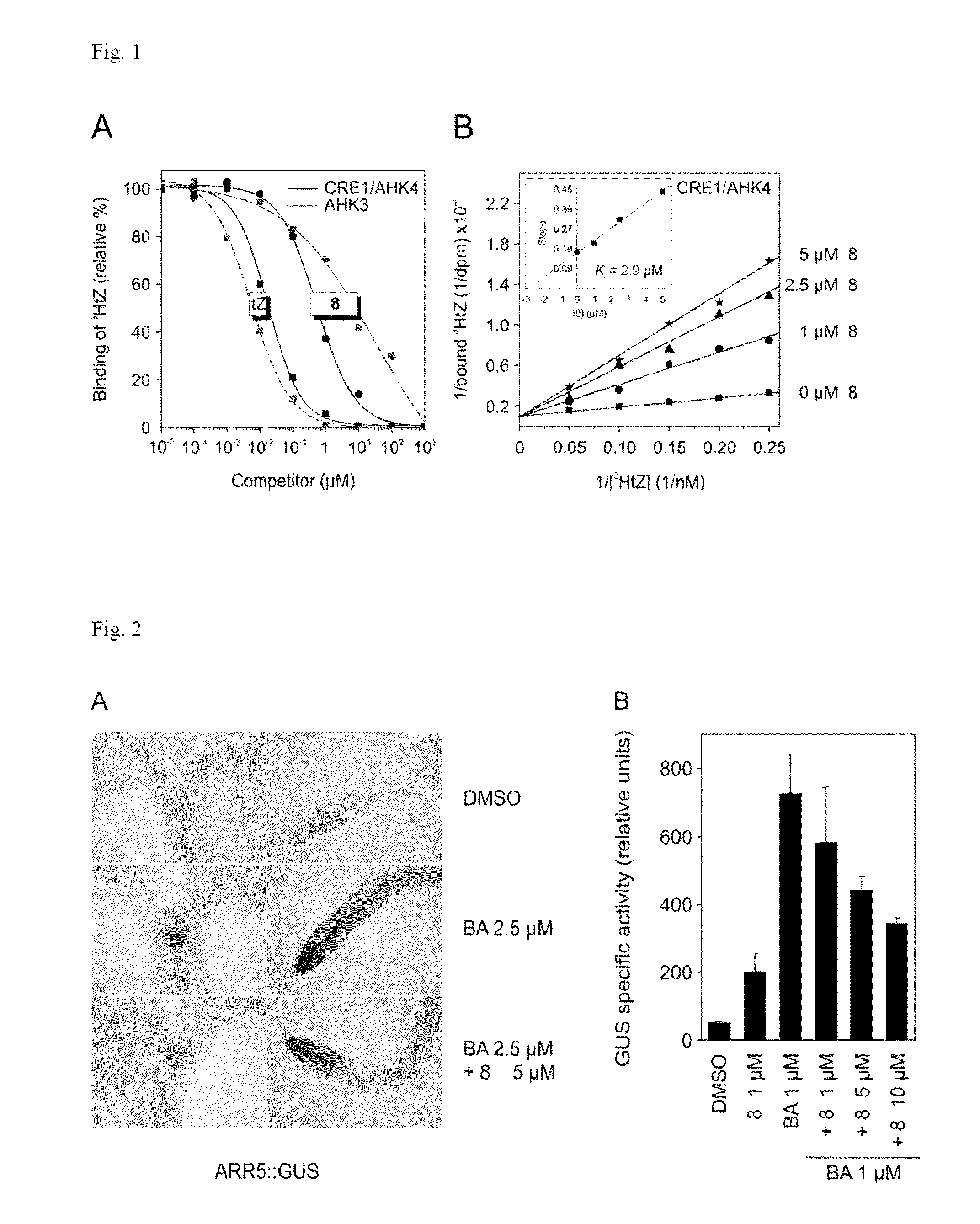Substituted 6-(alkylbenzylamino)purine derivatives for use as cytokinin receptor antagonists and preparations containing these derivatives
a technology of alkylbenzylamino and purine derivatives, which is applied in the field of cytokinin, can solve the problems of lack of direct proof that cytokinin receptors are the sites of cytokinin-anticytokinin interactions, and achieve the effect of strong decrease or complete loss of cytokinin activity
- Summary
- Abstract
- Description
- Claims
- Application Information
AI Technical Summary
Benefits of technology
Problems solved by technology
Method used
Image
Examples
example 1
Preparation of 6-(2-hydroxy-3-methylbenzylamino)purine
[0041]3 mmol 6-chloropurine were disolved in 15 ml butanol and 4 mmol 2-hydroxy-3-methylbenzylamine and 5 mmol triethylamine were added. The solution was kept at 90° C. for 4 hours. After cooling to room temperature the precipitate was filtered off and recrystallised from ethanol. M.p. 276-277° C. TLC: chloroform-methanol-ammonia (90:9:1): no impurities and starting material; HPLC purity: 98+%. Yield 92%.
TABLE 1Compounds Prepared by the method of Example 1MS ANALYSES-ZMDPREPARED COMPOUNDSCHN ANALYSES [%][M − H]− a)[M + H]+ b)16-(2-amino-3-methylbenzylamino)purineC = 60.8; H = 5.7; N = 32.725325526-(2-amino-4-methylbenzylamino)purineC = 61.2; H = 5.6; N = 32.925325536-(2-amino-5-methylbenzylamino)purineC = 61.2; H = 5.6; N = 32.925325546-(2-amino-3-ethylbenzylamino)purineC = 62.4; H = 6.0; N = 31.126726956-(2-amino-5-ethylbenzylamino)purineC = 62.5; H = 6.0; N = 31.226726966-(2-amino-3-isopropylbenzylamino)purineC = 63.8; H = 6.1;...
example 2
Agonistic Activity on Cytokinin Receptors
[0042]Escherichia coli strains KMI001 harbouring the plasmid pIN-III-AHK4 or pSTV28-AHK3 were grown overnight at 25° C. in M9 media enriched with 0.1% casamino acids to OD600˜1. The preculture was diluted 1:600 in 1 ml M9 medium containing 0.1% casamino acids and 1 μl stock solution of either the tested compound (10−7 M−5×10−5 M) or solvent control (DMSO, ethanol, methanol) were added. The cultures were further grown at 25° C. in microtiter plate, 200 μl per well. Incubation times of 17 h and 28 h were found to be optimal for CRE1 / AHK4 and AHK3, respectively. The cultures were centrifuged and 50 μl aliquots of the supernatant were transferred to microtiter plate containing 2 μl 50 mM 4-methyl umbelliferyl galactoside which was subsequently incubated for 1 h at 37° C. The reaction was stopped by adding 100 μl 0.2 M Na2CO3. Fluorescence was measured using a Fluoroscan Ascent (Labsystems, Finland) at the excitation and emission wavelengths of 36...
example 3
Inhibition of Binding of Natural Ligand to Cytokinin Receptor by 6-(2-hydroxy-3-methylbenzylamino)purine (Compound 8)
[0044]For the binding assay membranes isolated from E. coli expressing cytokinin receptors CRE1 / AHK4 and AHK3 were used (see example 2). Isolation of E. coli membranes and binding assays were carried out as previously described by Romanov et al. (Romanov et al. Analytical Biochemistry 347:129-134, 2005). In the assay the influence of increasing concentration of competitor (compound 8) on binding of radiolabeled natural ligand trans-zeatin (3HtZ) was tested. Non-labeled trans-zeatin (tZ) was used as positive and adenine as negative controls. Compound 8 was able to decrease the binding of 3HtZ to 50% in 3 μM concentration (FIG. 1), whereas even 1000-fold higher concentration of adenine was not effective at all.
PUM
 Login to View More
Login to View More Abstract
Description
Claims
Application Information
 Login to View More
Login to View More - R&D
- Intellectual Property
- Life Sciences
- Materials
- Tech Scout
- Unparalleled Data Quality
- Higher Quality Content
- 60% Fewer Hallucinations
Browse by: Latest US Patents, China's latest patents, Technical Efficacy Thesaurus, Application Domain, Technology Topic, Popular Technical Reports.
© 2025 PatSnap. All rights reserved.Legal|Privacy policy|Modern Slavery Act Transparency Statement|Sitemap|About US| Contact US: help@patsnap.com



